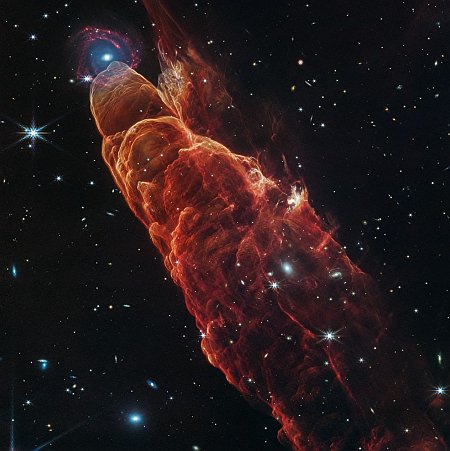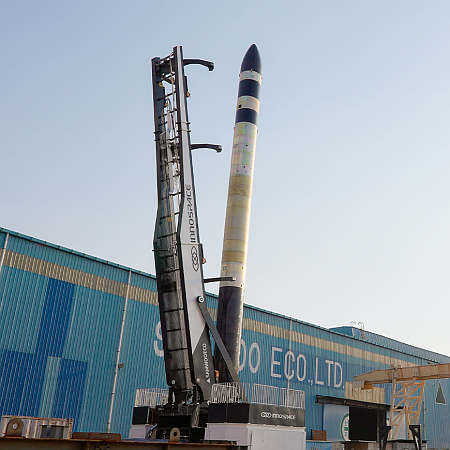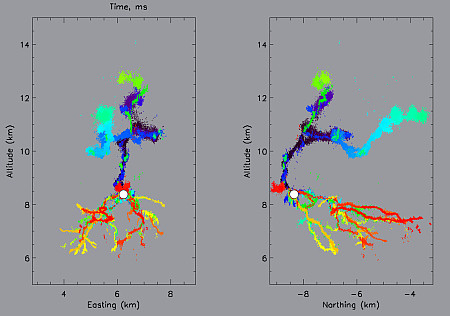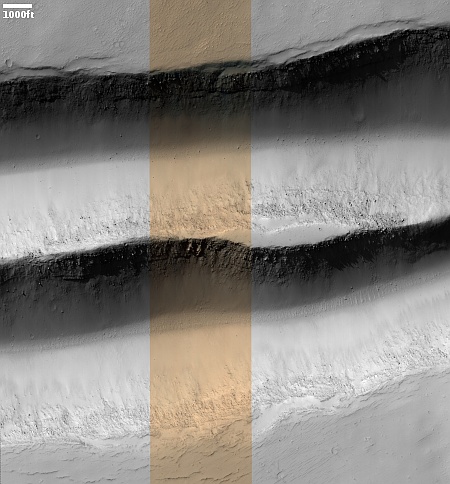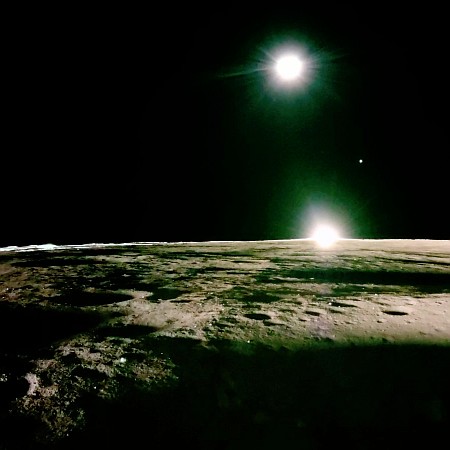March 24, 2025 Quick space links
Courtesy of BtB’s stringer Jay. This post is also an open thread. I welcome my readers to post any comments or additional links relating to any space issues, even if unrelated to the links below.
- Summary of Chinese rockets which plan to have maiden flights in 2025
Lists ten new rockets. I am willing to bet that half will not fly this year, and a good percentage will never fly. The successes however will be important, since some include reusability.
- On this day in 1965 Ranger 9 successfully crashed on the Moon, as planned
Link includes a video made up of the photos taken as the spacecraft descended.
- Hubble image showing the impact clouds on Jupiter from Comet Shoemaker-Levy’s collision in 1994
Fortunately the impact occurred after Hubble’s eyesight was fixed.
- Ten years ago today the Mars rover Opportunity exceeded 26.2 miles, the length of a marathon
It is still a record for any rover, but expect both Curiosity and Perseverance to eventually break it.
Courtesy of BtB’s stringer Jay. This post is also an open thread. I welcome my readers to post any comments or additional links relating to any space issues, even if unrelated to the links below.
- Summary of Chinese rockets which plan to have maiden flights in 2025
Lists ten new rockets. I am willing to bet that half will not fly this year, and a good percentage will never fly. The successes however will be important, since some include reusability.
- On this day in 1965 Ranger 9 successfully crashed on the Moon, as planned
Link includes a video made up of the photos taken as the spacecraft descended.
- Hubble image showing the impact clouds on Jupiter from Comet Shoemaker-Levy’s collision in 1994
Fortunately the impact occurred after Hubble’s eyesight was fixed.
- Ten years ago today the Mars rover Opportunity exceeded 26.2 miles, the length of a marathon
It is still a record for any rover, but expect both Curiosity and Perseverance to eventually break it.
On Christmas Eve 1968 three Americans became the first humans to visit another world. What they did to celebrate was unexpected and profound, and will be remembered throughout all human history. Genesis: the Story of Apollo 8, Robert Zimmerman's classic history of humanity's first journey to another world, tells that story, and it is now available as both an ebook and an audiobook, both with a foreword by Valerie Anders and a new introduction by Robert Zimmerman.
The print edition can be purchased at Amazon or any other book seller. If you want an autographed copy the price is $60 for the hardback and $45 for the paperback, plus $8 shipping for each. Go here for purchasing details. The ebook is available everywhere for $5.99 (before discount) at amazon, or direct from my ebook publisher, ebookit you don't support the big tech companies and the author gets a bigger cut much sooner.
The audiobook is also available at all these vendors, and is also free with a 30-day trial membership to Audible.
"Not simply about one mission, [Genesis] is also the history of America's quest for the moon... Zimmerman has done a masterful job of tying disparate events together into a solid account of one of America's greatest human triumphs."--San Antonio Express-News
SpaceX launches reconnaissance satellite for National Reconnaissance Office
SpaceX today successfully placed a classified reconnaissance payload into orbit for National Reconnaissance Office, its Falcon 9 rocket lifting off from Cape Canaveral in Florida.
The first stage completed its second flight, landing back at Cape Canaveral.
The leaders in the 2025 launch race:
34 SpaceX
14 China
4 Russia
4 Rocket Lab
SpaceX now leads the rest of the world in successfully launches, 34 to 25.
SpaceX today successfully placed a classified reconnaissance payload into orbit for National Reconnaissance Office, its Falcon 9 rocket lifting off from Cape Canaveral in Florida.
The first stage completed its second flight, landing back at Cape Canaveral.
The leaders in the 2025 launch race:
34 SpaceX
14 China
4 Russia
4 Rocket Lab
SpaceX now leads the rest of the world in successfully launches, 34 to 25.
New Webb infrared image reveals galaxy hidden behind outflow from baby star
Cool image time! The false-color infrared image to the right, cropped, reduced, and sharpened to post here, was taken by the Webb Space Telescope of the outflow from a baby star, dubbed Herbig-Haro 49/50, located about 625 light years away.
The picture was taken to get a better understanding of the flow itself. Earlier infrared images at much lower resolution by the Spitzer Space Telescope had left many features in this outflow unclear. For example, at the head of the outflow the Spitzer infrared image was unable to clearly identify the background spiral galaxy located there. In those earlier images it could have instead been a part of the outflow itself.
The galaxy that appears by happenstance at the tip of HH 49/50 is a much more distant, face-on spiral galaxy. It has a prominent central bulge represented in blue that shows the location of older stars. The bulge also shows hints of “side lobes” suggesting that this could be a barred-spiral galaxy. Reddish clumps within the spiral arms show the locations of warm dust and groups of forming stars. The galaxy even displays evacuated bubbles in these dusty regions
The actual source from which this flow comes remains unconfirmed, though astronomers think the source is one particular protostar about 1.5 light years away.
Cool image time! The false-color infrared image to the right, cropped, reduced, and sharpened to post here, was taken by the Webb Space Telescope of the outflow from a baby star, dubbed Herbig-Haro 49/50, located about 625 light years away.
The picture was taken to get a better understanding of the flow itself. Earlier infrared images at much lower resolution by the Spitzer Space Telescope had left many features in this outflow unclear. For example, at the head of the outflow the Spitzer infrared image was unable to clearly identify the background spiral galaxy located there. In those earlier images it could have instead been a part of the outflow itself.
The galaxy that appears by happenstance at the tip of HH 49/50 is a much more distant, face-on spiral galaxy. It has a prominent central bulge represented in blue that shows the location of older stars. The bulge also shows hints of “side lobes” suggesting that this could be a barred-spiral galaxy. Reddish clumps within the spiral arms show the locations of warm dust and groups of forming stars. The galaxy even displays evacuated bubbles in these dusty regions
The actual source from which this flow comes remains unconfirmed, though astronomers think the source is one particular protostar about 1.5 light years away.
Now available in hardback and paperback as well as ebook!
From the press release: In this ground-breaking new history of early America, historian Robert Zimmerman not only exposes the lie behind The New York Times 1619 Project that falsely claims slavery is central to the history of the United States, he also provides profound lessons about the nature of human societies, lessons important for Americans today as well as for all future settlers on Mars and elsewhere in space.
Conscious Choice: The origins of slavery in America and why it matters today and for our future in outer space, is a riveting page-turning story that documents how slavery slowly became pervasive in the southern British colonies of North America, colonies founded by a people and culture that not only did not allow slavery but in every way were hostile to the practice.
Conscious Choice does more however. In telling the tragic history of the Virginia colony and the rise of slavery there, Zimmerman lays out the proper path for creating healthy societies in places like the Moon and Mars.
“Zimmerman’s ground-breaking history provides every future generation the basic framework for establishing new societies on other worlds. We would be wise to heed what he says.” —Robert Zubrin, founder of the Mars Society.
All editions are available at Amazon, Barnes & Noble, and all book vendors, with the ebook priced at $5.99 before discount. All editions can also be purchased direct from the ebook publisher, ebookit, in which case you don't support the big tech companies and the author gets a bigger cut much sooner.
Autographed printed copies are also available at discount directly from the author (hardback $29.95; paperback $14.95; Shipping cost for either: $6.00). Just send an email to zimmerman @ nasw dot org.
Rolling Stone provides more details about Jared Isaacman and his nomination as NASA administrator

Jared Isaacman
This article from Rolling Stone published yesterday provides a wealth of new information about Jared Isaacman, Trump’s still unconfirmed pick to become NASA’s next administrator.
Two key details: First, the article quotes Isaacman saying he opposes NASA’s policy of signing up two companies, SpaceX and Blue Origin, to build manned lunar landers.
I will try to help, but this is why I get frustrated at two lunar lander contracts, when will be lucky to get to the [Moon] a few times in the next decade. People falsely assume its because I want SpaceX to win it all, but budgets are not unlimited & unfortunate casualties happen.
In other words, he opposes using NASA to develop an aerospace industry with multiple companies capable of doing things NASA needs done. He also appears to dismiss the value of redundancy that two landers provides.
Second, the article provides links to the financial [pdf] and ethics [pdf] disclosures that he submitted to the government after being named as nominee. In the financial statement he indicates he paid SpaceX more than $50 million for providing the transportation for his multi-mission Dragon/Starship Polaris Dawn manned program. In the ethics statement he asserts he would end that contract if confirmed as NASA administrator, with SpaceX refunding any monies for services not yet rendered. The program itself would be suspended until Isaacman completes his term as administrator.
The Rolling Stone article, though detailed and fair-minded, appears to strongly endorse Isaacman, and thus joins a growing public campaign from many insider Washington players — a large number of whom have been passionately hostile to Donald Trump — to get Isaacman approved. At the moment however his nomination appears stalled because the Trump administration has not yet submitted to the Senate the paperwork needed to allow that body to schedule hearings.
The strange campaign by many of Trump’s opponents to endorse Isaacman continues to suggest to me that the Trump administration has had second thoughts about its NASA nominee. The swamp now wants him, and this is raising hackles inside the administration, which thus explains the slow-walking of his paperwork.

Jared Isaacman
This article from Rolling Stone published yesterday provides a wealth of new information about Jared Isaacman, Trump’s still unconfirmed pick to become NASA’s next administrator.
Two key details: First, the article quotes Isaacman saying he opposes NASA’s policy of signing up two companies, SpaceX and Blue Origin, to build manned lunar landers.
I will try to help, but this is why I get frustrated at two lunar lander contracts, when will be lucky to get to the [Moon] a few times in the next decade. People falsely assume its because I want SpaceX to win it all, but budgets are not unlimited & unfortunate casualties happen.
In other words, he opposes using NASA to develop an aerospace industry with multiple companies capable of doing things NASA needs done. He also appears to dismiss the value of redundancy that two landers provides.
Second, the article provides links to the financial [pdf] and ethics [pdf] disclosures that he submitted to the government after being named as nominee. In the financial statement he indicates he paid SpaceX more than $50 million for providing the transportation for his multi-mission Dragon/Starship Polaris Dawn manned program. In the ethics statement he asserts he would end that contract if confirmed as NASA administrator, with SpaceX refunding any monies for services not yet rendered. The program itself would be suspended until Isaacman completes his term as administrator.
The Rolling Stone article, though detailed and fair-minded, appears to strongly endorse Isaacman, and thus joins a growing public campaign from many insider Washington players — a large number of whom have been passionately hostile to Donald Trump — to get Isaacman approved. At the moment however his nomination appears stalled because the Trump administration has not yet submitted to the Senate the paperwork needed to allow that body to schedule hearings.
The strange campaign by many of Trump’s opponents to endorse Isaacman continues to suggest to me that the Trump administration has had second thoughts about its NASA nominee. The swamp now wants him, and this is raising hackles inside the administration, which thus explains the slow-walking of his paperwork.
South Korean rocket startup Innospace details successful tests of its portable launchpad
The South Korean rocket startup Innospace has now provided some additional details about its testing of the portable launchpad and strongback that it will use on its first planned rocket launch in July 2025.
The Launch Pad-Vehicle Interface Integrated System Test comprehensively verifies the operational readiness of the launch vehicle and launch pad, covering processes from vehicle assembly and pad integration to vertical erection, propellant supply system checks, and final operational validation. During the test, INNOSPACE confirmed the mechanical and electrical interfaces between the launch pad and vehicle, the transporter erector launcher system, the detachment of the Umbilical, the fuel and oxidizer supply system, and the separation of the launch vehicle hold-down mechanism, ensuring technical reliability and operational stability.
The launch pad that successfully completed the test, is scheduled for maritime transportation to the Alcântara Space Center in Brazil on April 2. Upon arrival in May, it will undergo installation and final verification in the local environment to complete preparations for launch operations. In addition, the launch vehicle used in this test was the HANBIT-Nano Qualification Model (QM), which shares the same specifications—21.8 meters in height and 1.4 meters in diameter—as the Flight Model (FM) scheduled for launch in July.
The company will still need to do these same tests in Brazil at its Alcântara spaceport using the actual rocket, dubbed Hanbit-Nano, before the launch can occur. Thus. meeting that July target date is likely difficult if not impossible. At the same time it does appear the company has a chance of launching before the end of this year.
The South Korean rocket startup Innospace has now provided some additional details about its testing of the portable launchpad and strongback that it will use on its first planned rocket launch in July 2025.
The Launch Pad-Vehicle Interface Integrated System Test comprehensively verifies the operational readiness of the launch vehicle and launch pad, covering processes from vehicle assembly and pad integration to vertical erection, propellant supply system checks, and final operational validation. During the test, INNOSPACE confirmed the mechanical and electrical interfaces between the launch pad and vehicle, the transporter erector launcher system, the detachment of the Umbilical, the fuel and oxidizer supply system, and the separation of the launch vehicle hold-down mechanism, ensuring technical reliability and operational stability.
The launch pad that successfully completed the test, is scheduled for maritime transportation to the Alcântara Space Center in Brazil on April 2. Upon arrival in May, it will undergo installation and final verification in the local environment to complete preparations for launch operations. In addition, the launch vehicle used in this test was the HANBIT-Nano Qualification Model (QM), which shares the same specifications—21.8 meters in height and 1.4 meters in diameter—as the Flight Model (FM) scheduled for launch in July.
The company will still need to do these same tests in Brazil at its Alcântara spaceport using the actual rocket, dubbed Hanbit-Nano, before the launch can occur. Thus. meeting that July target date is likely difficult if not impossible. At the same time it does appear the company has a chance of launching before the end of this year.
Leaving Earth: Space Stations, Rival Superpowers, and the Quest for Interplanetary Travel, can be purchased as an ebook everywhere for only $3.99 (before discount) at amazon, Barnes & Noble, all ebook vendors, or direct from my ebook publisher, ebookit.
If you buy it from ebookit you don't support the big oppressive tech companies and I get a bigger cut much sooner.
Winner of the 2003 Eugene M. Emme Award of the American Astronautical Society.
"Leaving Earth is one of the best and certainly the most comprehensive summary of our drive into space that I have ever read. It will be invaluable to future scholars because it will tell them how the next chapter of human history opened." -- Arthur C. Clarke
Perseverance spots a rock made of many tiny spherules
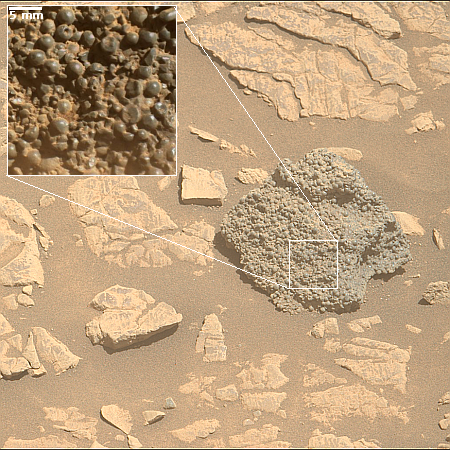
Click for wide shot. The original of the inset
can be found here.
In their exploration of the outer flanks of the rim of Jezero Crater, the science team operating the Perseverance rover have discovered an unusual rock different than everything around it, appearing to be made of many very tiny spherules.
The picture to the right illustrates this. The wider picture was taken by Perseverance’s left high resolution camera, with the inset a close-up mosaic of three images taken by the rover’s micro-imager, designed to get very very high resolution pictures of small objects. From the press release:
The rock, named “St. Pauls Bay” by the team, appeared to be comprised of hundreds of millimeter-sized, dark gray spheres. Some of these occurred as more elongate, elliptical shapes, while others possessed angular edges, perhaps representing broken spherule fragments. Some spheres even possessed tiny pinholes! What quirk of geology could produce these strange shapes?
This isn’t the first time strange spheres have been spotted on Mars. In 2004, the Mars Exploration Rover Opportunity spotted so-called, “Martian Blueberries” at Meridiani Planum, and since then, the Curiosity rover has observed spherules in the rocks of Yellowknife Bay at Gale crater. Just a few months ago, Perseverance itself also spied popcorn-like textures in sedimentary rocks exposed in the Jezero crater inlet channel, Neretva Vallis. In each of these cases, the spherules were interpreted as concretions, features that formed by interaction with groundwater circulating through pore spaces in the rock.
Not all spherules form this way, however. They also form on Earth by rapid cooling of molten rock droplets formed in a volcanic eruption, for instance, or by the condensation of rock vaporized by a meteorite impact.
At the moment the science team has no idea which of these theories explains the spherules. That the rock is located on the crater rim, where ejecta from the impact will be found, strongly suggests the impact was the cause, not groundwater flow.

Click for wide shot. The original of the inset
can be found here.
In their exploration of the outer flanks of the rim of Jezero Crater, the science team operating the Perseverance rover have discovered an unusual rock different than everything around it, appearing to be made of many very tiny spherules.
The picture to the right illustrates this. The wider picture was taken by Perseverance’s left high resolution camera, with the inset a close-up mosaic of three images taken by the rover’s micro-imager, designed to get very very high resolution pictures of small objects. From the press release:
The rock, named “St. Pauls Bay” by the team, appeared to be comprised of hundreds of millimeter-sized, dark gray spheres. Some of these occurred as more elongate, elliptical shapes, while others possessed angular edges, perhaps representing broken spherule fragments. Some spheres even possessed tiny pinholes! What quirk of geology could produce these strange shapes?
This isn’t the first time strange spheres have been spotted on Mars. In 2004, the Mars Exploration Rover Opportunity spotted so-called, “Martian Blueberries” at Meridiani Planum, and since then, the Curiosity rover has observed spherules in the rocks of Yellowknife Bay at Gale crater. Just a few months ago, Perseverance itself also spied popcorn-like textures in sedimentary rocks exposed in the Jezero crater inlet channel, Neretva Vallis. In each of these cases, the spherules were interpreted as concretions, features that formed by interaction with groundwater circulating through pore spaces in the rock.
Not all spherules form this way, however. They also form on Earth by rapid cooling of molten rock droplets formed in a volcanic eruption, for instance, or by the condensation of rock vaporized by a meteorite impact.
At the moment the science team has no idea which of these theories explains the spherules. That the rock is located on the crater rim, where ejecta from the impact will be found, strongly suggests the impact was the cause, not groundwater flow.
NASA drops its DEI emphasis on race and sex in describing who will fly on first Artemis lunar landing
Not surprisingly, considering Trump’s executive orders demanding all government agencies discontinue their racial and sex quotas based on the bigoted Diversity, Equity, and Inclusion (DEI) policies, NASA has now deleted any mention of launching the first “woman and person of color” on its first Artemis lunar landing mission.
The Artemis landing page of Nasa’s website previously included the words: “Nasa will land the first woman, first person of color, and first international partner astronaut on the Moon using innovative technologies to explore more of the lunar surface than ever before.” The version of the page live on the website on Friday, however, appears with the phrase removed.
During the Biden administration every single press release about this first Artemis lunar landing touted these racial and sexual qualifications, as if it was the only thing that mattered in choosing the right astronauts for the job. It was not only illegal discrimination against men and whites, it was insulting to minorities and women.
This change in language does not mean that NASA will now purposely exclude “women or people of color” from that mission. Instead, it ends the emphasis on race and sex. The astronauts NASA chooses for the flight will now be picked based on more important considerations, such as experience and talent. Picking someone because of their race or gender is like picking someone because of the color of their eyes or hair. It is stupid and misguided. Trump has now ended that stupidity.
Or at least he is forcing NASA’s management make its bigotry less obvious. We should not be surprised if that management still intends to make race and sex a major criteria. They will simply no longer blast that decision with a bullhorn.
Not surprisingly, considering Trump’s executive orders demanding all government agencies discontinue their racial and sex quotas based on the bigoted Diversity, Equity, and Inclusion (DEI) policies, NASA has now deleted any mention of launching the first “woman and person of color” on its first Artemis lunar landing mission.
The Artemis landing page of Nasa’s website previously included the words: “Nasa will land the first woman, first person of color, and first international partner astronaut on the Moon using innovative technologies to explore more of the lunar surface than ever before.” The version of the page live on the website on Friday, however, appears with the phrase removed.
During the Biden administration every single press release about this first Artemis lunar landing touted these racial and sexual qualifications, as if it was the only thing that mattered in choosing the right astronauts for the job. It was not only illegal discrimination against men and whites, it was insulting to minorities and women.
This change in language does not mean that NASA will now purposely exclude “women or people of color” from that mission. Instead, it ends the emphasis on race and sex. The astronauts NASA chooses for the flight will now be picked based on more important considerations, such as experience and talent. Picking someone because of their race or gender is like picking someone because of the color of their eyes or hair. It is stupid and misguided. Trump has now ended that stupidity.
Or at least he is forcing NASA’s management make its bigotry less obvious. We should not be surprised if that management still intends to make race and sex a major criteria. They will simply no longer blast that decision with a bullhorn.
March 21, 2025 Zimmerman/Batchelor podcast
Embedded below the fold in two parts.
To listen to all of John Batchelor’s podcasts, go here.
» Read more
Embedded below the fold in two parts.
To listen to all of John Batchelor’s podcasts, go here.
» Read more
Gamazda – Metallica’s Nothing Else Matters
March 21, 2025 Quick space links
Courtesy of BtB’s stringer Jay. This post is also an open thread. I welcome my readers to post any comments or additional links relating to any space issues, even if unrelated to the links below.
- NASA’s SPHEREx space telescope ejects its dust cover
The telescope will compile a spectroscopic sky survey over its two-year prime mission.
- European Space Agency (ESA) releases a report outlining its overall strategy through 2040
Contains lots of typical bureaucratic blather. It actually means little, as the real strategies are presently being established by the individual European nations independent of this central bureaucracy. Rather than depend on ESA, the member nations are one-by-one encouraging private enterprise, not government projects. ESA is likely going to become a backwater in the next decade, and unnecessary after that.
Courtesy of BtB’s stringer Jay. This post is also an open thread. I welcome my readers to post any comments or additional links relating to any space issues, even if unrelated to the links below.
- NASA’s SPHEREx space telescope ejects its dust cover
The telescope will compile a spectroscopic sky survey over its two-year prime mission.
- European Space Agency (ESA) releases a report outlining its overall strategy through 2040
Contains lots of typical bureaucratic blather. It actually means little, as the real strategies are presently being established by the individual European nations independent of this central bureaucracy. Rather than depend on ESA, the member nations are one-by-one encouraging private enterprise, not government projects. ESA is likely going to become a backwater in the next decade, and unnecessary after that.
The insane left keeps shooting itself in the foot!
The recent string of vandalism of Tesla vehicles as well as swatting attacks on well known conservatives by leftist crazies might be scary, horrifying, and disgusting, but if you take a step back from these emotions for a second to look dispassionately at the situation, you will realize these attacks are only the dying screams of a bankrupt political movement that has no proposals, no ideas, and no goals except the obtaining of power — now through the use of violence because its political support has dropped to such record lows.
First, the attacks are beyond senseless. In the case of the vandalism of Teslas, the attacks are actually doing harm to those who in the past were most likely to have supported the Democratic Party’s leftist political agenda. Conservatives in general have not been buying electric vehicles, because they have no need to virtue signal leftist climate goals. So, by damaging Teslas owned by innocent bystanders, just because the car was built by a company founded by Elon Musk, the vandals are not only not winning converts to their cause, they are making enemies of people who were once on their side.
» Read more
New research finds cosmic rays hitting the atmosphere cause of the ignition of lightning
New research has now found that the shower of energy produced when a cosmic ray hits the atmosphere could be a major cause for the ignition of lightning in thunderheads.
You can read the paper here. The two graphs to the right are taken from figure 3 of the paper, and show two different lightning events. The colors represent time, going from green (earliest) to blue to yellow and red (latest). The white dot marks the spot where the lightning flash started. From the article above:
We believe that that most lightning flashes in thunderstorms are ignited by cosmic ray showers,” says the study’s lead author Xuan-Min Shao, a senior scientist at the Los Alamos National Laboratory in New Mexico.
…One of the important things about cosmic ray showers is that they contain antimatter–positrons as well as ordinary electrons. The Los Alamos 3D lightning maps contained strong evidence for positrons. Electrons and positrons are bent in opposite directions by Earth’s magnetic field, so they leave opposite imprints on the lightning’s polarization, which BIMAP-3D also measured.
…Positrons clinched the case for cosmic rays. “The fact that a cosmic ray shower provides an ionized path in the cloud that otherwise lacks free electrons strongly favor the inference that most lightning flashes are ignited by cosmic rays,” the authors wrote.
It remains unclear if cosmic rays cause all lightning flashes or just some. Either way, it is a remarkable thing to consider: Cosmic rays are created in distant interstellar and even intergalactic events. The rays take millions, maybe billions of years to reach Earth. And when they do, they produce lightning in thunderstorms!
Hat tip reader Steve Golson.
New research has now found that the shower of energy produced when a cosmic ray hits the atmosphere could be a major cause for the ignition of lightning in thunderheads.
You can read the paper here. The two graphs to the right are taken from figure 3 of the paper, and show two different lightning events. The colors represent time, going from green (earliest) to blue to yellow and red (latest). The white dot marks the spot where the lightning flash started. From the article above:
We believe that that most lightning flashes in thunderstorms are ignited by cosmic ray showers,” says the study’s lead author Xuan-Min Shao, a senior scientist at the Los Alamos National Laboratory in New Mexico.
…One of the important things about cosmic ray showers is that they contain antimatter–positrons as well as ordinary electrons. The Los Alamos 3D lightning maps contained strong evidence for positrons. Electrons and positrons are bent in opposite directions by Earth’s magnetic field, so they leave opposite imprints on the lightning’s polarization, which BIMAP-3D also measured.
…Positrons clinched the case for cosmic rays. “The fact that a cosmic ray shower provides an ionized path in the cloud that otherwise lacks free electrons strongly favor the inference that most lightning flashes are ignited by cosmic rays,” the authors wrote.
It remains unclear if cosmic rays cause all lightning flashes or just some. Either way, it is a remarkable thing to consider: Cosmic rays are created in distant interstellar and even intergalactic events. The rays take millions, maybe billions of years to reach Earth. And when they do, they produce lightning in thunderstorms!
Hat tip reader Steve Golson.
Oxygen found in the most distant known galaxy, too soon after the Big Bang
The uncertainty of science: Astronomers studying the most distant galaxy so far discovered, 13.4 billion light years away and existing only 300 million years after the Big Bang, have now detected the existence of oxygen, an element that simply should not have had the time to develop in such a short time span.
The new oxygen detection with ALMA, a telescope array in Chile’s Atacama Desert, suggests the galaxy is much more chemically mature than expected. “It is like finding an adolescent where you would only expect babies,” says Sander Schouws, a PhD candidate at Leiden Observatory, the Netherlands, and first author of the Dutch-led study, now accepted for publication in The Astrophysical Journal. “The results show the galaxy has formed very rapidly and is also maturing rapidly, adding to a growing body of evidence that the formation of galaxies happens much faster than was expected.”
Galaxies usually start their lives full of young stars, which are made mostly of light elements like hydrogen and helium. As stars evolve, they create heavier elements like oxygen, which get dispersed through their host galaxy after they die. Researchers had thought that, at 300 million years old, the Universe was still too young to have galaxies ripe with heavy elements. However, the two ALMA studies indicate JADES-GS-z14-0 has about 10 times more heavy elements than expected.
The spectroscopy that confirmed the oxygen also allowed the scientists to confirm the galaxy’s distance, which also confirmed the fact that there is something seriously wrong with the present theories of cosmologists about the formation of the universe. Present theory requires at least several generations of star birth followed by star death, with each forming heavier and heavier atoms. Such a process is expected to take far more than 300 million years.
Either that theory is very wrong, or the theory of the Big Bang has problems. The facts don’t fit the theories, and when that happens, it is the theories that must be abandoned.
The uncertainty of science: Astronomers studying the most distant galaxy so far discovered, 13.4 billion light years away and existing only 300 million years after the Big Bang, have now detected the existence of oxygen, an element that simply should not have had the time to develop in such a short time span.
The new oxygen detection with ALMA, a telescope array in Chile’s Atacama Desert, suggests the galaxy is much more chemically mature than expected. “It is like finding an adolescent where you would only expect babies,” says Sander Schouws, a PhD candidate at Leiden Observatory, the Netherlands, and first author of the Dutch-led study, now accepted for publication in The Astrophysical Journal. “The results show the galaxy has formed very rapidly and is also maturing rapidly, adding to a growing body of evidence that the formation of galaxies happens much faster than was expected.”
Galaxies usually start their lives full of young stars, which are made mostly of light elements like hydrogen and helium. As stars evolve, they create heavier elements like oxygen, which get dispersed through their host galaxy after they die. Researchers had thought that, at 300 million years old, the Universe was still too young to have galaxies ripe with heavy elements. However, the two ALMA studies indicate JADES-GS-z14-0 has about 10 times more heavy elements than expected.
The spectroscopy that confirmed the oxygen also allowed the scientists to confirm the galaxy’s distance, which also confirmed the fact that there is something seriously wrong with the present theories of cosmologists about the formation of the universe. Present theory requires at least several generations of star birth followed by star death, with each forming heavier and heavier atoms. Such a process is expected to take far more than 300 million years.
Either that theory is very wrong, or the theory of the Big Bang has problems. The facts don’t fit the theories, and when that happens, it is the theories that must be abandoned.
China and SpaceX complete launches
Two more launches since yesterday. First, SpaceX successfully launched a National Reconnaissance Office classified surveillance satellite, its Falcon 9 rocket lifting off shortly before midnight from Vandenberg in California.
The first stage not only completed its fourth flight, landing back at Vandenberg, it did so setting a new record for the shortest turnaround from its previous flight, only ten days previously. The fairings completed their fourth and seventh flights respectively.
China then followed, with its pseudo-company Galactic Energy placing six weather satellites into orbit, its solid-fueled Ceres-1 rocket lifting off from the Jiuquan spaceport in northwest China. China’s state run press provided no information on where the rocket’s lower stages crashed inside China. This was the second launch for Galactic Energy this week, and the nineteenth overall, making it the most successful Chinese pseudo-company. That its rocket is solid-fueled tells us that it is based on missile technology, which also tells us that the company is not really an independent company as we conceive it in the west, but closely controlled and supervised by China’s military.
The leaders in the 2025 launch race:
33 SpaceX
14 China
4 Russia
4 Rocket Lab
SpaceX now leads the rest of the world in successfully launches, 33 to 25.
Two more launches since yesterday. First, SpaceX successfully launched a National Reconnaissance Office classified surveillance satellite, its Falcon 9 rocket lifting off shortly before midnight from Vandenberg in California.
The first stage not only completed its fourth flight, landing back at Vandenberg, it did so setting a new record for the shortest turnaround from its previous flight, only ten days previously. The fairings completed their fourth and seventh flights respectively.
China then followed, with its pseudo-company Galactic Energy placing six weather satellites into orbit, its solid-fueled Ceres-1 rocket lifting off from the Jiuquan spaceport in northwest China. China’s state run press provided no information on where the rocket’s lower stages crashed inside China. This was the second launch for Galactic Energy this week, and the nineteenth overall, making it the most successful Chinese pseudo-company. That its rocket is solid-fueled tells us that it is based on missile technology, which also tells us that the company is not really an independent company as we conceive it in the west, but closely controlled and supervised by China’s military.
The leaders in the 2025 launch race:
33 SpaceX
14 China
4 Russia
4 Rocket Lab
SpaceX now leads the rest of the world in successfully launches, 33 to 25.
Beto and the Fairlanes – Right Clickin’
March 20, 2025 Quick space links
Courtesy of BtB’s stringer Jay. This post is also an open thread. I welcome my readers to post any comments or additional links relating to any space issues, even if unrelated to the links below.
- New Horizons detects too much ultra-violet light coming from blank patch of sky
Or to put it more clearly, this is just another example of the uncertainty of science.
- Commercial radar satellite company Iceye assures the Ukraine it will continue to make its orbital data available
I am sure Iceye is being well paid for its data.
- Starlink competitor in the Falklands touts his company as superior
It appears he is trying to hold onto his monopoly, and failing.
- On Gemini 3 this week in 1965 astronaut John Young took out a corned beef sandwich, bought at a local restaurant, and ate it while in orbit
The NASA bureaucracy, mighty pissed off at Young for doing this, imposed new stricter rules thereafter on what astronauts could take on board their flight. Young, who was one of America’s truly great space pioneers, never suffered however, flying two Gemini missions, two Apollo missions, and two shuttle missions.
Courtesy of BtB’s stringer Jay. This post is also an open thread. I welcome my readers to post any comments or additional links relating to any space issues, even if unrelated to the links below.
- New Horizons detects too much ultra-violet light coming from blank patch of sky
Or to put it more clearly, this is just another example of the uncertainty of science.
- Commercial radar satellite company Iceye assures the Ukraine it will continue to make its orbital data available
I am sure Iceye is being well paid for its data.
- Starlink competitor in the Falklands touts his company as superior
It appears he is trying to hold onto his monopoly, and failing.
- On Gemini 3 this week in 1965 astronaut John Young took out a corned beef sandwich, bought at a local restaurant, and ate it while in orbit
The NASA bureaucracy, mighty pissed off at Young for doing this, imposed new stricter rules thereafter on what astronauts could take on board their flight. Young, who was one of America’s truly great space pioneers, never suffered however, flying two Gemini missions, two Apollo missions, and two shuttle missions.
NASA’s still undecided as to Starliner’s next flight

Starliner docked to ISS.
Though it now appears that the management at both NASA and Boeing are still committed to getting Boeing’s manned Starliner capsule certified for commercial flights, NASA remains undecided as to the scope and nature of the capsule’s next test flight.
[T]esting will be a big part of the next Starliner flight, whenever it lifts off. “We need to make sure we can eliminate the helium leaks; eliminate the service module thruster issues that we had on docking,” [said Steve Stich, manager of NASA’s Commercial Crew Program].
NASA has not yet decided whether the coming Starliner flight will carry astronauts or not, he added. But even if the mission is uncrewed, the agency wants it to be crew-capable — “to have all the systems in place that we could fly a crew with,” Stich said. “As I think about it, it might be there for a contingency situation, as we prepare for whatever events could happen,” he added. “One of the things that I’ve learned in my time at NASA is, always be prepared for the unexpected.”
NASA plans to certify Starliner for operational, long-duration astronaut missions shortly after this next flight, if all goes well.
Stich’s comments took place during a press conference following the return of the Starliner crew on SpaceX’s Freedom capsule.
There had been rumors last year that NASA would pay Boeing to use Starliner on a cargo mission to ISS, thus saving the company the cost of flying another demo mission on its own dime. I suspect those plans have now been squashed by the Trump administration, which is likely to insist that Boeing honor the deal in its fixed price contract. If so, the next flight will once again be a demo mission to prove the capsule’s systems, paid for by Boeing. Whether astronauts fly on it will be a political decision made by Trump, with advice from NASA management. And that decision cannot occur until NASA’s new administrator is confirmed and has had time to review the situation.

Starliner docked to ISS.
Though it now appears that the management at both NASA and Boeing are still committed to getting Boeing’s manned Starliner capsule certified for commercial flights, NASA remains undecided as to the scope and nature of the capsule’s next test flight.
[T]esting will be a big part of the next Starliner flight, whenever it lifts off. “We need to make sure we can eliminate the helium leaks; eliminate the service module thruster issues that we had on docking,” [said Steve Stich, manager of NASA’s Commercial Crew Program].
NASA has not yet decided whether the coming Starliner flight will carry astronauts or not, he added. But even if the mission is uncrewed, the agency wants it to be crew-capable — “to have all the systems in place that we could fly a crew with,” Stich said. “As I think about it, it might be there for a contingency situation, as we prepare for whatever events could happen,” he added. “One of the things that I’ve learned in my time at NASA is, always be prepared for the unexpected.”
NASA plans to certify Starliner for operational, long-duration astronaut missions shortly after this next flight, if all goes well.
Stich’s comments took place during a press conference following the return of the Starliner crew on SpaceX’s Freedom capsule.
There had been rumors last year that NASA would pay Boeing to use Starliner on a cargo mission to ISS, thus saving the company the cost of flying another demo mission on its own dime. I suspect those plans have now been squashed by the Trump administration, which is likely to insist that Boeing honor the deal in its fixed price contract. If so, the next flight will once again be a demo mission to prove the capsule’s systems, paid for by Boeing. Whether astronauts fly on it will be a political decision made by Trump, with advice from NASA management. And that decision cannot occur until NASA’s new administrator is confirmed and has had time to review the situation.
March 19, 2025 Zimmerman/Batchelor podcast
Embedded below the fold in two parts.
To listen to all of John Batchelor’s podcasts, go here.
» Read more
Embedded below the fold in two parts.
To listen to all of John Batchelor’s podcasts, go here.
» Read more
Camille Saint-Saëns – from the Symphony No. 3
An evening pause: Performed live December 7, 2024 for the reopening of Notre Dame in Paris. Gustavo Dudamel is the conductor, leading Olivier Latry and the Orchestre Philharmonique de Radio France.
Hat tip Judd Clark.
March 19, 2025 Quick space links
Courtesy of BtB’s stringer Jay. This post is also an open thread. I welcome my readers to post any comments or additional links relating to any space issues, even if unrelated to the links below.
- Andoya spaceport signs partnership deal with satellite packager Exolaunch
Exolaunch will act to help Andoya integrate satellites on future launches.
- Chinese pseudo-company touts its capsules for both manned and cargo flights
It claims it will begin test flights in “2027 or 2028,” but the graphic at the link mostly shows copies of Dragon and Cygnus capsules.
- Exlabs and Antares form partnership to develop spacecraft using nuclear power for operations
The idea is to create better on-board power systems so that interplanetary missions will be less reliant on solar power.
- This week in 2011 NASA’s Messenger spacecraft became the first to enter Mercury orbit
It operated for four years, collecting data and images.
Courtesy of BtB’s stringer Jay. This post is also an open thread. I welcome my readers to post any comments or additional links relating to any space issues, even if unrelated to the links below.
- Andoya spaceport signs partnership deal with satellite packager Exolaunch
Exolaunch will act to help Andoya integrate satellites on future launches.
- Chinese pseudo-company touts its capsules for both manned and cargo flights
It claims it will begin test flights in “2027 or 2028,” but the graphic at the link mostly shows copies of Dragon and Cygnus capsules.
- Exlabs and Antares form partnership to develop spacecraft using nuclear power for operations
The idea is to create better on-board power systems so that interplanetary missions will be less reliant on solar power.
- This week in 2011 NASA’s Messenger spacecraft became the first to enter Mercury orbit
It operated for four years, collecting data and images.
High ridge down the center of a big Martian crack
Cool image time! The picture to the right, rotated, cropped, reduced, and sharpened to post here, was taken on January 27, 2025 by the high resolution camera on Mars Reconnaissance Orbiter (MRO). Labeled simply as a “terrain sample,” it was likely taken not as part of any specific research project but to fill a gap in the schedule in order to maintain the camera’s proper temperature.
Whenever the camera team needs to do this, they try to find an interesting object to photograph, and often succeed. In this case they focused on the geology to the right. I suspect that at first glance my readers will have trouble deciphering what they are looking at. Let me elucidate: This this a 2.5-mile-wide canyon, about 1,000 feet deep, that is bisected by a ridge about 500 feet high.
On the sunlight walls of this canyon you can see boulders and debris, with material gathered on the canyon floor. The smoothness of the floor suggests also that a lot of Martian dust, likely volcanic ash, has become trapped there over the eons.
» Read more
Cool image time! The picture to the right, rotated, cropped, reduced, and sharpened to post here, was taken on January 27, 2025 by the high resolution camera on Mars Reconnaissance Orbiter (MRO). Labeled simply as a “terrain sample,” it was likely taken not as part of any specific research project but to fill a gap in the schedule in order to maintain the camera’s proper temperature.
Whenever the camera team needs to do this, they try to find an interesting object to photograph, and often succeed. In this case they focused on the geology to the right. I suspect that at first glance my readers will have trouble deciphering what they are looking at. Let me elucidate: This this a 2.5-mile-wide canyon, about 1,000 feet deep, that is bisected by a ridge about 500 feet high.
On the sunlight walls of this canyon you can see boulders and debris, with material gathered on the canyon floor. The smoothness of the floor suggests also that a lot of Martian dust, likely volcanic ash, has become trapped there over the eons.
» Read more
Firefly releases movie of lunar sunset
Using imagery taken by Firefly’s Blue Ghost lander, the company today released a short movie showing sunset on the Moon, from several different angles.
I have embedded that movie below. The picture to the right, cropped, reduced, and sharpened to post here, is one of the photos from that movie. It shows the Sun on the horizon, with the Earth above it and Venus the small bright dot in between.
One alien aspect of the Moon that that while the Sun (and Venus) slowly crossed the sky during Firefly’s two week mission, going from just after sunrise in the east to sunset in the west, the Earth remained stationary in this location above the horizon. This phenomenon occurs because the length of the Moon’s day and its orbit around the Earth are the same length, so that one hemisphere always faces the Earth. Blue Ghost landed in Mare Crisium on the eastern edge of that hemisphere. At that location the Earth always hangs at this spot in the sky.
» Read more
Using imagery taken by Firefly’s Blue Ghost lander, the company today released a short movie showing sunset on the Moon, from several different angles.
I have embedded that movie below. The picture to the right, cropped, reduced, and sharpened to post here, is one of the photos from that movie. It shows the Sun on the horizon, with the Earth above it and Venus the small bright dot in between.
One alien aspect of the Moon that that while the Sun (and Venus) slowly crossed the sky during Firefly’s two week mission, going from just after sunrise in the east to sunset in the west, the Earth remained stationary in this location above the horizon. This phenomenon occurs because the length of the Moon’s day and its orbit around the Earth are the same length, so that one hemisphere always faces the Earth. Blue Ghost landed in Mare Crisium on the eastern edge of that hemisphere. At that location the Earth always hangs at this spot in the sky.
» Read more
Billy Joel – The Downeaster Alexa
Freedom capsule splashes down successfully
SpaceX’s Freedom capsule has successfully splashed down off the coast of Florida, and has now been fished out of the water.
UPDATE: All four astronauts have now exited the capsule.
In watching the live stream, it is important to once again note that no one involved in this recovery operation is a government employee. The entire operation is being run by SpaceX, a private American company doing this work for profit.
It will take a bit more time before the astronauts come out of the capsule, as they must do some leak checks to make sure everything is safe.
SpaceX’s Freedom capsule has successfully splashed down off the coast of Florida, and has now been fished out of the water.
UPDATE: All four astronauts have now exited the capsule.
In watching the live stream, it is important to once again note that no one involved in this recovery operation is a government employee. The entire operation is being run by SpaceX, a private American company doing this work for profit.
It will take a bit more time before the astronauts come out of the capsule, as they must do some leak checks to make sure everything is safe.
March 18, 2025 Quick space links
Courtesy of BtB’s stringer Jay. This post is also an open thread. I welcome my readers to post any comments or additional links relating to any space issues, even if unrelated to the links below.
- China touts another new rocket doing tower tests
No information other than two pictures.
- Update on the testing status of Sierra Nevada’s first Dream Chaser cargo shuttle, Tenacity
Includes almost no new information. Suggests the first launch will occur “this year,” which seems remarkable vague considering previously they thought they would launch last spring.
- On this day in 1965 Russian Alexei Leonov became the first person to do a spacewalk
The spacewalk had been quickly improvised to beat the planned American spacewalk during its Gemini program, and so the spacesuit ballooned out so much during the walk Leonov initially could not get back through the hatch. He had to literally dump some of his own air to shrink the suit enough to squeeze back in.
Courtesy of BtB’s stringer Jay. This post is also an open thread. I welcome my readers to post any comments or additional links relating to any space issues, even if unrelated to the links below.
- China touts another new rocket doing tower tests
No information other than two pictures.
- Update on the testing status of Sierra Nevada’s first Dream Chaser cargo shuttle, Tenacity
Includes almost no new information. Suggests the first launch will occur “this year,” which seems remarkable vague considering previously they thought they would launch last spring.
- On this day in 1965 Russian Alexei Leonov became the first person to do a spacewalk
The spacewalk had been quickly improvised to beat the planned American spacewalk during its Gemini program, and so the spacesuit ballooned out so much during the walk Leonov initially could not get back through the hatch. He had to literally dump some of his own air to shrink the suit enough to squeeze back in.
SpaceX launches 23 more Starlink satellites, including 13 with phone-to-satellite capabilities
SpaceX today successfully launched another 23 Starlink satellites, its Falcon 9 rocket lifting off from Cape Canaveral in Florida.
The first stage completed its nineteenth flight, landing on a drone ship in the Atlantic.
The leaders in the 2025 launch race:
32 SpaceX
13 China
4 Russia
4 Rocket Lab
SpaceX now leads the rest of the world in successfully launches, 32 to 24.
SpaceX today successfully launched another 23 Starlink satellites, its Falcon 9 rocket lifting off from Cape Canaveral in Florida.
The first stage completed its nineteenth flight, landing on a drone ship in the Atlantic.
The leaders in the 2025 launch race:
32 SpaceX
13 China
4 Russia
4 Rocket Lab
SpaceX now leads the rest of the world in successfully launches, 32 to 24.
More surprises from the Wolf-Rayet star numbered 104 and known for its pinwheel structure
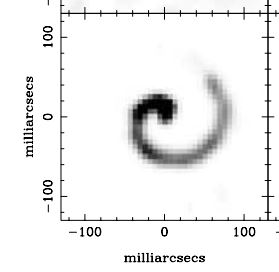
Among astronomers who study such things, Wolf-Rayet 104 is one of the most well known OB massive stars in their catalog, with the infrared picture to the right illustrating why. The star is actually a binary of massive stars, orbiting each other every eight months. Both produce strong winds, and the collision of those winds results in a glorious pinwheel structure that glows in the infrared.
Such stars are also believed to be major candidates to go supernova and in doing so produce a powerful gamma ray burst (GRB) that would shoot out from the star’s poles. As the orientation of this pinwheel suggests we are looking down into the pole of the system, this star system was actually considered a potentially minor threat to Earth. Located about 8,400 light years away, this is far enough away to mitigate the power of the GRB, but not eliminate entirely its ability to damage the Earth’s atmosphere.
New research now suggests however that despite the orientation of the pinwheel, face-on, the plane of the binary star system is actually tilted 30 to 40 degrees to our line of sight. The press release asks the new questions these results raise:
While a relief for those worried about a nearby GRB pointed right at us, this represents a real curveball. How can the dust spiral and the orbit be tilted so much to each other? Are there more physics that needs to be considered when modelling the formation of the dust plume?
You can read the paper here. It is a quite refreshing read, not just because of its relatively plain language lacking jargon, but because of its willingness to list at great length the uncertainties of the data.

Among astronomers who study such things, Wolf-Rayet 104 is one of the most well known OB massive stars in their catalog, with the infrared picture to the right illustrating why. The star is actually a binary of massive stars, orbiting each other every eight months. Both produce strong winds, and the collision of those winds results in a glorious pinwheel structure that glows in the infrared.
Such stars are also believed to be major candidates to go supernova and in doing so produce a powerful gamma ray burst (GRB) that would shoot out from the star’s poles. As the orientation of this pinwheel suggests we are looking down into the pole of the system, this star system was actually considered a potentially minor threat to Earth. Located about 8,400 light years away, this is far enough away to mitigate the power of the GRB, but not eliminate entirely its ability to damage the Earth’s atmosphere.
New research now suggests however that despite the orientation of the pinwheel, face-on, the plane of the binary star system is actually tilted 30 to 40 degrees to our line of sight. The press release asks the new questions these results raise:
While a relief for those worried about a nearby GRB pointed right at us, this represents a real curveball. How can the dust spiral and the orbit be tilted so much to each other? Are there more physics that needs to be considered when modelling the formation of the dust plume?
You can read the paper here. It is a quite refreshing read, not just because of its relatively plain language lacking jargon, but because of its willingness to list at great length the uncertainties of the data.
Isar confirms March 20, 2025 for first launch

Proposed spaceports surrounding Norwegian Sea
The German rocket startup Isar Aerospace has now confirmed that it will attempt the first orbital test launch of its Spectrum rocket on March 20, 2025, lifting off from Norway’s Andoya spaceport.
Isar announced March 17 that the Norwegian Civil Aviation Authority (CAA) issued a launch operator license to the company for its Spectrum rocket, launching from Andøya Spaceport in northern Norway. The launch, called “Going Full Spectrum” by the company, is a test flight of Spectrum with no customer payloads on board. “Our goal is to test each and every component and system of the launch vehicle,” Alexandre Dalloneau, vice president of mission and launch operations at Isar Aerospace, said in a statement about the upcoming launch.
Isar Aerospace did not announce a specific time for the launch, noting the timing would depend on weather as well as range and vehicle readiness.
This launch is also going to be the first vertical orbital rocket launch from the European continent, and will put Andoya ahead of the three other spaceports being developed in the United Kingdom and Sweden. For the two UK spaceports this launch will be especially embarrassing, as both started years before Andoya but have been endlessly hampered by red tape, government interference, and local lawsuits. Norway meanwhile has moved with alacrity in approving Andoya’s permits and Isar’s launch licenses.
As for Isar, this launch puts it in the lead over the half dozen or so new European rocket startups as the first to attempt a launch. None of the others are close to that first launch attempt, though the German startup Rocket Factory Augsburg came close last year. During its last static fire test of the first stage prior to launch the rocket was destroyed in a fire.

Proposed spaceports surrounding Norwegian Sea
The German rocket startup Isar Aerospace has now confirmed that it will attempt the first orbital test launch of its Spectrum rocket on March 20, 2025, lifting off from Norway’s Andoya spaceport.
Isar announced March 17 that the Norwegian Civil Aviation Authority (CAA) issued a launch operator license to the company for its Spectrum rocket, launching from Andøya Spaceport in northern Norway. The launch, called “Going Full Spectrum” by the company, is a test flight of Spectrum with no customer payloads on board. “Our goal is to test each and every component and system of the launch vehicle,” Alexandre Dalloneau, vice president of mission and launch operations at Isar Aerospace, said in a statement about the upcoming launch.
Isar Aerospace did not announce a specific time for the launch, noting the timing would depend on weather as well as range and vehicle readiness.
This launch is also going to be the first vertical orbital rocket launch from the European continent, and will put Andoya ahead of the three other spaceports being developed in the United Kingdom and Sweden. For the two UK spaceports this launch will be especially embarrassing, as both started years before Andoya but have been endlessly hampered by red tape, government interference, and local lawsuits. Norway meanwhile has moved with alacrity in approving Andoya’s permits and Isar’s launch licenses.
As for Isar, this launch puts it in the lead over the half dozen or so new European rocket startups as the first to attempt a launch. None of the others are close to that first launch attempt, though the German startup Rocket Factory Augsburg came close last year. During its last static fire test of the first stage prior to launch the rocket was destroyed in a fire.
Curiosity’s newest view from the heights
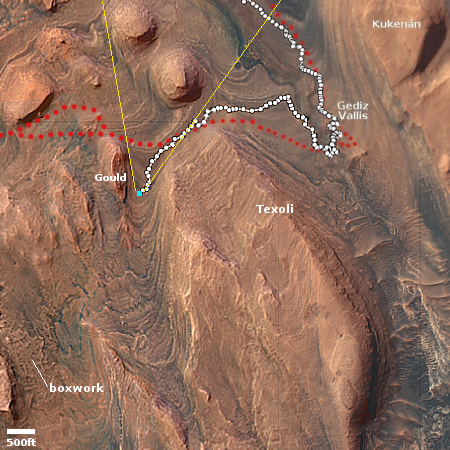
Click for interactive map.
Cool image time! The panorama above, cropped slightly to post here, was taken today by the right navigation camera on the Mars rover Curiosity. It looks north from the rover’s present location on the flank of Mount Sharp, with the rim of Gale Crater in the far distance about 20 to 30 miles away. Curiosity now sits about 3,000 feet above the floor of the crater.
The blue dot on the overview map to the right marks the rover’s position at this time. The yellow lines indicate the approximate view of the panorama. As with all of the images from both Curiosity and Perseverance, the main impression is a barren and lifeless landscape of incredible stark beauty.
It is now very evident that the Curiosity science team has made the decision to abandon their original route to the west. Instead, they have decided to strike south up into this canyon because it provides them the easiest and fastest route to the boxwork geology to the southwest. It also has them climbing into new geological layers rather than descending into layers that the rover has already seen.

Click for interactive map.
Cool image time! The panorama above, cropped slightly to post here, was taken today by the right navigation camera on the Mars rover Curiosity. It looks north from the rover’s present location on the flank of Mount Sharp, with the rim of Gale Crater in the far distance about 20 to 30 miles away. Curiosity now sits about 3,000 feet above the floor of the crater.
The blue dot on the overview map to the right marks the rover’s position at this time. The yellow lines indicate the approximate view of the panorama. As with all of the images from both Curiosity and Perseverance, the main impression is a barren and lifeless landscape of incredible stark beauty.
It is now very evident that the Curiosity science team has made the decision to abandon their original route to the west. Instead, they have decided to strike south up into this canyon because it provides them the easiest and fastest route to the boxwork geology to the southwest. It also has them climbing into new geological layers rather than descending into layers that the rover has already seen.


